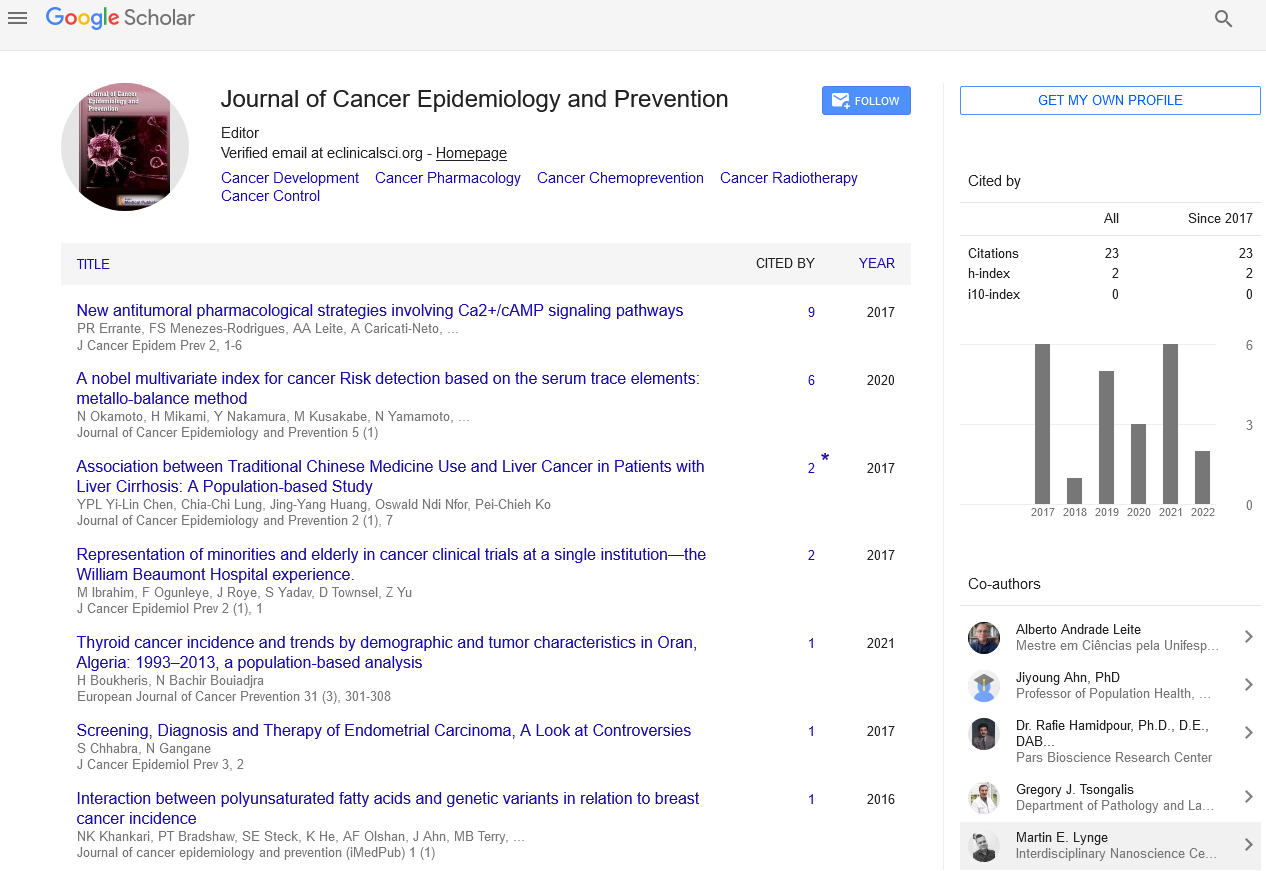Commentary - (2022) Volume 7, Issue 2
Chemotherapeutic Specialists are Cytotoxic through Obstructing Cellular Division
Tsubaki Yuki*
Department of Radio Oncology, Akureyri University, Greenland
*Correspondence:
Tsubaki Yuki, Department of Radio Oncology, Akureyri University,
Greenland,
Email:
Received: 30-Mar-2022, Manuscript No. IPJCEP-22-13349 ;
Editor assigned: 01-Apr-2022, Pre QC No. IPJCEP-22-13349 (PQ);
Reviewed: 15-Apr-2022, QC No. IPJCEP-22-13349;
Revised: 22-Apr-2022, Manuscript No. IPJCEP-22-13349 (R);
Published:
29-Apr-2022, DOI: 10.36648/ipjcep.7.2.06
Description
Significantly, the use of medicines (whether chemotherapy,
hormonal treatment or designated treatment) is prime treatment
for malignant growth therein they’re brought into the circulation
system and are hence on a basic level able to address
disease at any anatomic area within the body. Fundamental
treatment is repeatedly utilized associated with different modalities
that comprise neighborhood treatment (for example
therapies whose viability is sure to the anatomic region where
they’re applied) for malignant growth like radiation treatment,
procedure or hyperthermia treatment.
Customary chemotherapeutic specialists are cytotoxic through
obstructing cellular division (mitosis) however disease cells
change generally in their powerlessness to those specialists.
Generally, chemotherapy are often considered a way for harming
or stress cells, which can then prompt cell passing within
the event that apoptosis is started. An outsized number of the
symptoms of chemotherapy are often followed to harm to typical
cells that partition quickly and are hence touchy to against
mitotic medications: cells within the bone marrow, digestive
system and hair follicles. This outcomes within the most generally
recognized results of chemotherapy: myelosuppression,
mucositis (aggravation of the coating of the gastrointestinal
system), and alopecia (going bald).
On account of the impact on insusceptible cells, chemotherapy
medicates frequently hunt use during a large group of sicknesses
that outcome from hurtful overactivity of the invulnerable
framework against self (alleged autoimmunity). These incorporate
rheumatoid joint inflammation, foundational LE, various
scleroses, vasculitis and various others. You would possibly get
chemotherapy in an emergency clinic or reception, a specialist’s
office, or a clinical facility. You’ll tend the medications orally,
in a shot, as a cream, through a catheter, or intravenously.
Your therapy plan will depend on the type of malignant growth you’ve got, which chemotherapy meds are utilized, the treatment
objectives, and the way your body answers the prescriptions.
Chemotherapy could be given alone or with different medicines.
You would possibly seek treatment consistently, consistently,
or consistently. You would possibly have breaks between
medicines so your body gets a chance to construct new sound
cells. You would possibly have chemotherapy in “cycles,” which
implies a time of treatment and afterward a time of rest. As an
example, a 4-week cycle could be multi week of treatment and
afterward 3 weeks of rest. The remainder permits your body to
form new sound cells. When a cycle has been arranged out, it’s
better to not avoid a treatment, but rather your PCP might propose
it on the off chance that incidental effects are significant.
Then your clinical group will probably design another cycle to
help you with refocusing.
Distribution of the Lindskog article recommending the result
of compound within the therapy of lymphoma meaningfully
affected the development of disease chemotherapy, including
oral subsidiaries like chlorambucil and eventually cyclophosphamide.
The revelation of actinomycin D spearheaded the
search for extra antitumor anti-microbials, including anthracyclines,
mitomycin, and bleomycin. Farber et al., in 1947,
showed outcome within the treatment of young life leukemia
by utilizing antimetabolites with antifolate action, called aminopterin,
later are referred to as methotrexate.
The fruitful administration of choriocarcinoma and leukemias
with methotrexate prompted further examinations in malignant
growth chemotherapy. Furthermore, drugs like thiopurines
(e.g., 6-mercaptopurine), 5-fluorouracil came into the
front of malignant growth treatment. Nowell et al. targeting
the connection of movement of chromosomes 9 and 22 to a
couple of leukemias, which later prompted fostering the principal
sub-atomic designated medicines years after the very fact (imatinib). Charles Huggins won a Nobel Prize in 1966 for
examinations on chemical treatment in prostate disease. This
work was a venturing stone to a different period of chemical
treatment, with the presentation of medicines like tamoxifen
and anastrozole, and so on.
With an expanded comprehension of the science of disease,
there are currently a couple of remedial monoclonal antibodies
accessible. Rituximab and trastuzumab were endorsed during
the last a part of the 1990s to treat lymphoma and bosom disease,
individually. Atomic designated treatment is differently to affect malignant growth treatment. A couple of specialists have
gotten endorsement from the U.S. Food and Drug Administration
(FDA) somewhat recently.
Acknowledgement
None.
Conflict of Interest
The authors declare that they have no conflict of interest.
Citation: Tsubaki Yuki (2022). Chemotherapeutic Specialists are Cytotoxic through Obstructing Cellular Division. J Cancer Epidemiol Prev. 7:06.
Copyright: © Tsubaki Yuki. This is an open-access article distributed under the terms of the Creative Commons Attribution License, which permits unrestricted use, distribution, and reproduction in any medium, provided the original author and source are credited

